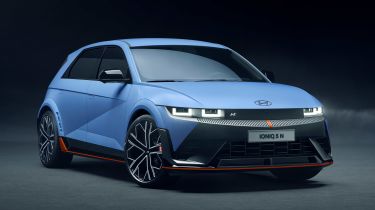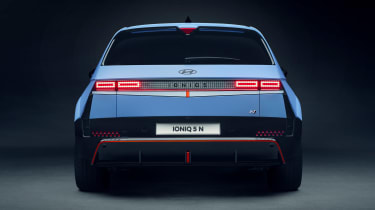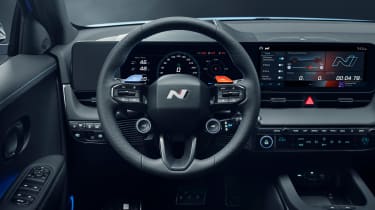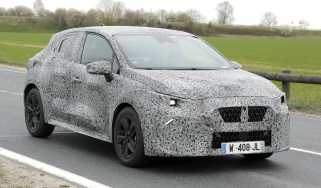New Hyundai Ioniq 5 N electric hot hatch breaks cover with 641bhp
The new performance EV from Hyundai's N division puts the focus on fun, with clever tech helping to make the Ioniq 5 N feel like a petrol hot hatch
The new Hyundai Ioniq 5 N is the Korean brand's first performance EV, and Hyundai says this new all-electric hot crossover puts the focus on driving fun.
A host of new systems and tech feature on the car to put the driver at the heart of the experience, something that some brands have struggled to achieve with their EVs. With that in mind, Hyundai’s N division has developed a new system, called N e-shift, which replicates the feel of a high-performance petrol engine and eight-speed dual-clutch automatic gearbox.
It's coupled with Hyundai's N Active Sound+ feature, and together these systems simulate a more conventional combustion-engined powertrain, with N e-shift adjusting the Ioniq 5 N's torque output from its pair of motors to feel like the car has gears. The tech will also deliver a small jolt to give the impression of gear shifts, and the driver can take manual control using the steering-wheel mounted paddles or leave the car in automatic mode. Toggle the system off and the Ioniq 5 N character returns to that of a single-speed automatic EV.
N Active Sound+ works alongside this tech to deliver a soundtrack also reminiscent of a petrol-powered Hyundai N car, while drivers can also choose a more futuristic soundtrack from within the infotainment system.
With the N Grin Boost function engaged (in effect a power hike limited to 10-second bursts), the Ioniq 5 N's dual-motor set-up produces a total of 641bhp, resulting in a 0-62mph time of 3.4 seconds in boost mode and with the car's N Launch Control engaged. Top speed stands at 161mph.
The Ioniq 5 N is is powered by a new 84kWh battery, which accepts charging at up to 350kW for a maximum 10-to-80 per cent top-up time of just 18 minutes. However, Hyundai has not yet revealed the car's claimed range and says it will outline this at “regional market launch”.
The car is equipped with N Battery Pre-conditioning, which can heat or cool the cells to the optimum temperature, depending on the mode selected. Drag sees a higher temperature reached to deliver short bursts of full power for maximum straight-line performance, while Track sees the cell temperature dialled back slightly in favour of endurance for circuit laps.
Further to this, an N Race setting allows drivers to choose between the level of power on offer, again depending on the type of driving environment. Sprint prioritises performance, while Endurance maximises range for a longer stint on track. To help with this, the Ioniq 5 N benefits from a revised cooling set-up for its battery coolant chiller and the heat exchanger for the car's motor oil.
The dual-motor drive system features an e-LSD built into the rear motor with an N Torque Distribution torque vectoring system that can be dialled up in 11 stages to optimise agility and attitude in corners, and it works with Hyundai's N Drift Optimiser function which “helps to maintain the drift angle by balancing multiple vehicle controls responding to real-time inputs”. There's also a function called Torque Kick Drift, which will simulate a clutch kick in a combustion-engined car in order to initiate a slide.
However, when it comes to driving systems, the car’s N Pedal is one of the most important. It's an evolution of the standard Ioniq 5's i-Pedal set-up, and while the Ioniq 5 N is fitted with 400mm front discs and four-piston monoblock brake calipers, with up to 0.6g of deceleration derived from the motors' brake regen in the strongest setting.
The system has been designed to combat the size and weight of an EV and deliver handling characteristics more closely aligned with those of a conventional hot hatch, including weight transfer to help with corner turn-in. The brand says that with significant deceleration coming from the motors, brake fade is also reduced on track.
There are many mechanical and set-up changes to the Ioniq 5 N compared with the standard car too, including 42 extra welds on the body and as much as 2.1 metres of extra adhesive, both improving rigidity. Hyundai says its integrated drive units have been inspired by its i20 World Rally Championship contender, reducing mass and allowing for extra motor torque to be deployed, while the car's motor and battery mounts, and the front and rear subframes, are all stiffer.
The 5 N's steering column features extra bracing to improve rigidity and feel, while the power-steering set-up also has a faster ratio than the regular car’s, for more direct response. Adaptive dampers control lightweight forged 21-inch alloy wheels wrapped in bespoke Pirelli P-Zero rubber, and the rims are part of a significant cosmetic makeover that includes a 20mm drop in ride height and a 50mm increase in bodywork width.
At the front, the requirements for the extra battery and motor cooling can be seen in the form of mesh grilles, while there are air curtains and flaps to help this feature too. A lip spoiler at the base of the deep front bumper increases the visual aggression, while at the rear, a big diffuser element (responsible for an 80mm increase in length compared with the standard Ioniq 5) works in conjunction with a high-level roof spoiler to boost downforce.
Inside, there are plenty of N-branded bits to reinforce the sporty theme, including new bucket seats with illuminated logos, a different design of steering wheel, fresh sill plates and N pedal caps. There also chequered-flag motifs dotted around outside and inside, reinforcing the N's sporty character.
The steering wheel features the firm's traditional N paddles and driving mode buttons to toggle between the different settings, while the centre console features padding for front occupants' legs. There's also storage, USB-C ports and a wireless charging pad as part of the centre console.
Full equipment specs and pricing have not yet been communicated, but we'll know more once the Ioniq 5 N goes on sale later this year, with deliveries set to start soon after towards the end of 2023 or into 2024. There’s no word yet on pricing, but a figure north of £60,000 seems likely.
Click here for our list of the fastest electric cars...
Find a car with the experts











